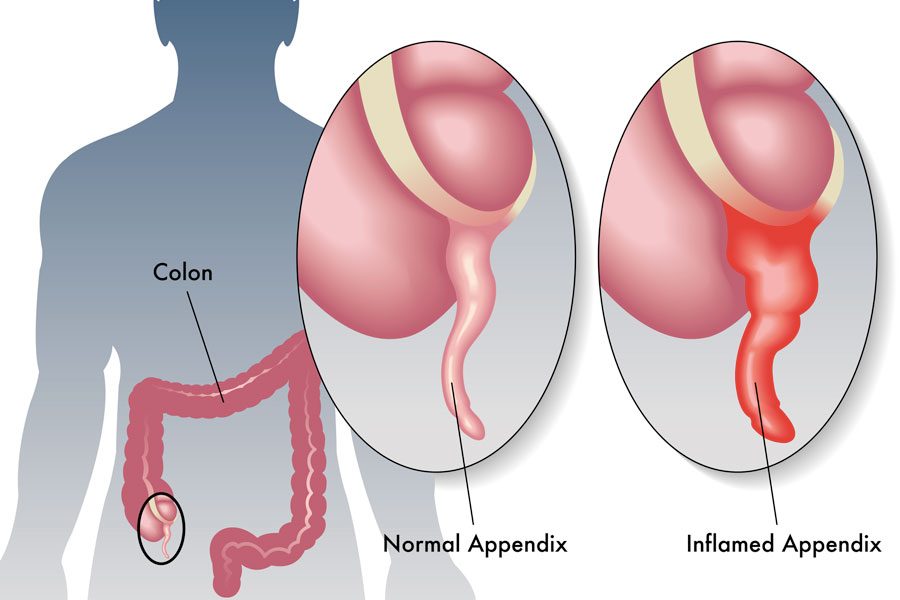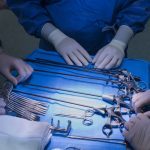There is no way to prevent appendicitis. It is an inflammation of the appendix and comes on suddenly. Acute appendicitis is a medical emergency that almost always requires prompt surgery procedure to remove the appendix.
Although it can strike at any age, appendicitis is most common in people between the ages of 10 and 30 years old.
Appendicitis is most commonly caused by obstruction of its opening into the colon with fecaliths (small stones). Other causes include swelling of the lymphoid tissue, barium contrast, tumor, vegetable and fruit seeds and intestinal parasites. Mucus builds up inside the appendix and its walls become distended. Eventually, an area of the appendix’s wall becomes necrotic and perforates.
Left untreated, an inflamed appendix will eventually burst, or perforate, spilling infectious materials into the abdominal cavity. This can lead to peritonitis, a serious inflammation of the peritoneum (the abdominal cavity’s lining) that can be fatal unless it is treated quickly with surgery and strong antibiotics.
How is it diagnosed?
Appendicitis is diagnosed through physical examination, blood tests, and commonly through an abdominal ultrasound. and CT scan. Patients hurt when they are touched in the right lower abdomen. Additionally, pain may result when the right thigh is moved or rotated. Blood tests usually show a high white blood cell count. An ultrasound of the abdomen is useful in women when there is concern that the cause of the pain might be from an ovary or fallopian tube.
Appendicitis occurs very swiftly. After the preliminary symptom, which is pain, the other symptoms will manifest within 24 hours. The time it usually takes for the blockage to form until the appendix ruptures is only 72 hours, and sometimes less.
This is why if you feel intense abdominal pain and experience the other signs above, you should contact your physician immediately. Most people are able to address this condition promptly, though, as the pain is so intense that they consult their physician 12 to 48 hours after it begins.
Common symptoms of appendicitis include:
- Pain in the belly. The pain may begin around the belly button.
- Pain in the belly that gets stronger and moves below the belly button to the lower right side.
- Pain that does not go away and gets worse when the person moves, walks, or coughs.
- Pain in any part of the belly or on the side.
- Nausea, throwing up, and not wanting to eat.
- Constipation, back pain, and a slight fever.
A general feeling of being sick, and a pain that is hard to describe.
If the infection gets worse, the wall of the appendix can break open (rupture). This spreads infection into the belly area, causing peritonitis. Peritonitis is a serious condition that, in rare cases, can lead to death.
Treatment
The main treatment for appendicitis is surgery to remove the appendix (appendectomy) which represents the standard treatment for almost all cases of appendicitis. Your surgeon may perform an open appendectomy or a laparoscopic appendectomy. Nowadays, the laparoscopic appendectomy is the gold standard, but the choice of type of surgery depends on the severity of your appendicitis.
Open appendectomy needs one incision in the lower right side of your abdomen to remove your appendix and then the wound is closed with stitches. This procedure allows your doctor to clean the abdominal cavity if your appendix has burst or if you have an abscess.
Laparoscopic appendectomy is a the standard surgery procedure which will be perform a few small incisions (two incisions of 1 cm and one of 5 mm) in your abdomen. The surgeon will insert a laparoscope (thin tube with a light and camera at the front) into the incisions. The camera will display the images on a screen, allowing to see inside your abdomen and guide the surgery instruments. When the surgeon find your appendix, they will tie it off with stitches and remove it. The small incisions will be close with the stiches.
The time it takes to recover from this procedure varies, depending on the type of surgery performed, the anesthesia used and if any complications have developed. It also depends on whether or not the appendix has already burst before surgery.
Laparoscopic surgery allows to obtain an enhanced recovery after surgery, and although you will be under observation for signs of infection, you will be allowed to leave one to two days after the surgery procedure.
A perforated appendix before surgery, however, is more crucial, as the infection needs to be treated. The recovery time in the hospital can take four days or longer, especially if complications develop. A drain will be attached to your abdomen to remove the pus.
Most appendectomy patients can resume their normal activities within a few days after the surgery procedure; however, strenuous activities like high-intensity exercises are ill advised for four weeks.















Very good lecture. Thanks so much.